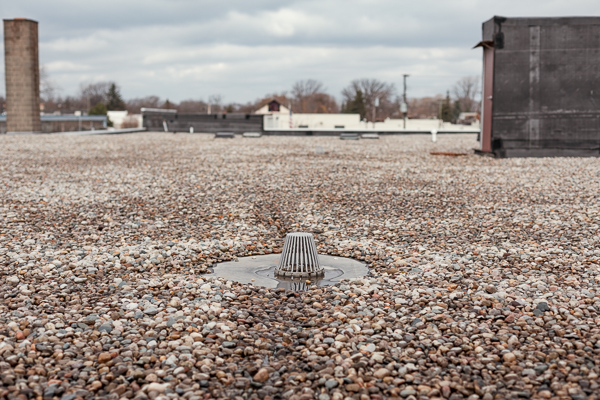Detroit property owners plan on green infrastructure to save on water bills
Nina Ignaczak |
Tuesday, December 20, 2016
Anthony Nader got a big surprise this past summer when he received notice that his employer, Milton Manufacturing, would be getting a significant hike on their water bill.
"It's a brand new fee," says Nader, who works as a facilities manager for the 65-year old metal and fabric manufacturing firm located near 7 Mile and John R. "For us, it amounts to $8,000 a month. If we look at it over the next ten years of doing business, it's going to cost us a million dollars.
"We were completely blindsided."
The fee is part of a program by the Detroit Water and Sewer Department (DWSD) to shore up costs related to maintaining the city's sewer infrastructure. Detroit's combined sewers handle both wastewater and stormwater runoff, and EPA regulations have required the city to invest heavily in CSO infrastructure over the years. One example is the Conner Creek facility on Detroit's lower east side, which helps to prevent overflow of mixed sewage and rainwater into the Detroit River and the Great Lakes.
According to Palencia Mobley, deputy director and chief engineer at Detroit Water and Sewerage Department, the fee is not new—what's new is how it's being presented to customers. DWSD is transitioning to a system in which customers are charged a fee based on the area of the impervious surface, such as concrete, pavement, and rooftop, located on their parcel.
"The drainage fee has been in effect since 1975," says Mobley, noting that before this year, the fee was a function of combined meter size and hard surface area. "What has occurred is that the data used to generate the charge has been updated, and so there are some customers who have never before received a bill."
The department is using remote sensing data to estimate the area of impervious surface on each parcel in the city. The new fee structure charges $750 per impervious acre per month for each parcel. According to the Detroit News, approximately 22,000 parcels in the city received notice of this overlooked fee, starting in August. And Nader's employer's parcel was one of them.
"We did not see it coming," says Nader. "Now at this point, all we can do to curb it is to do work and get some credit back on that bill."
 A drain on the roof of Milton Manufacturing's facility
A drain on the roof of Milton Manufacturing's facility
Nader is referring to DWSD's newdrainage charge credit program, which allows customers to reduce their drainage charge fee by implementing green infrastructure practices like bioretention, permeable pavement, and green roofs. By using these techniques, ratepayers can gain credits toward volume reduction and peak flow reduction, up to 80 percent of the total charge. Twenty percent of the charge is termed a "base fee" that covers operations, maintenance, and debt service on the existing infrastructure. How much a fee can be reduced depends on the particulars of the site and the potential for implementing green infrastructure.
"Each project is evaluated on a case-by-case basis," says Mobley. "The capital cost is based on which projects are best suited for the site and how far people want to go toward reducing their charge."
Nader worked with senior landscape architecture students from Michigan State University to develop a site plan that will hopefully reduce the drainage charge for the property he manages. His goal is to make sure the project pays off in the form of reduced drainage charge fees within ten years.
The plan involves rainwater harvesting using cisterns. That water will be used to irrigate Pingree Farms, an urban farm owned by Green Growth, an affiliate of Milton Manufacturing. Nader's next step is to gain approval from DWSD engineers.
"The DWSD people are trying to set you up for success and bring you in to make sure your plan is working and that you're going to get the credit that you expect," says Nader.
Nader's site has limited options for green infrastructure because of the sheer amount of impervious surface it contains. There is no opportunity for redirecting stormwater into a green area on the site. But he's intent on working with the city to reduce his runoff—and his costs.
"We're happy to comply because we know that in the end, it's for a good purpose," he says. "We're as environmentally conscious a company that you'll find in Detroit. We don't just dump oil down the drains, we don't just vent machines out of the building, we have environmental audits that we impose on ourselves that we have to comply with. We then go through checkpoints just to make sure we're always doing what's best for the environment to sustain the city and our resources."
Pastor Eli Garza of the First Spanish Baptist Church on Livernois in Southwest Detroit has some time before he needs to make a decision on how to reduce his fee. That's because the city is phasing the program out in stages. The program begins this year with parcels like Nader's that had never before received an assessment. Next up are industrial and commercial properties, followed by residential and tax-exempt properties. The city will assess the fee to parcels owned by faith-based organizations starting in January of 2018.
Right now, Garza is hoping to get the word out to other pastors and assist them in finding resources to develop green infrastructure projects. He acknowledges the fee will be a hardship for faith-based organizations, but he's optimistic that solutions can be found.
 Eli Garza
Eli Garza
"DWSD wants to reduce stormwater runoff, so therefore they want to help us do whatever we can to increase the amount of credits that we can get," says Garza. "They want to help you reduce storm water so that you can reduce your bill. When it hits you in the pocketbook, you jump."
Garza's church has some green space where stormwater can be redirected and retained on site, thus earning credit. But many churches may not have this option.
"Our neighborhood has a significant number of storefront-type churches where they bought old banks or old buildings," he says. "I don't even know if they can disconnect their downspout at all. Those properties are very small but still there's an added expense. Some people have absolutely nothing they can do."
Garza understands the motivation behind the new fee, because, ironically, he once worked as an engineer for DWSD.
"We had public meetings way back 35 years ago when we came up with the initial studies for the CSO basins," he says. "So I understand why all this is happening. And for many residential properties, it's not going to be a big deal because they can disconnect their downspouts, and that gives you a big credit. But for non-residential properties and especially for the churches, this will have a bigger impact."
This story is part of a series on measuring on the role of green infrastructure projects in Detroit's redevelopment. Support for this series is provided by the Erb Family Foundation to Greening of Detroit, Model D, and The Nature Conservancy. Read more articles from the series here.
All photos by Nick Hagen.